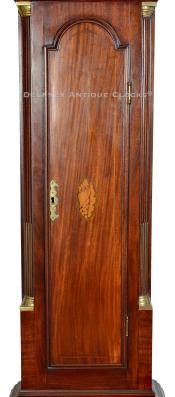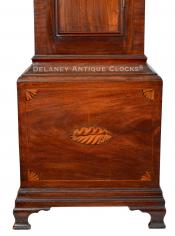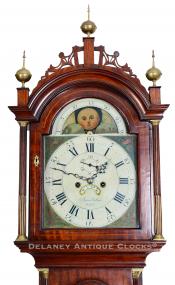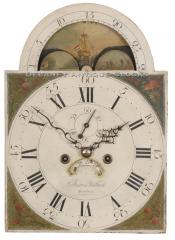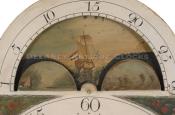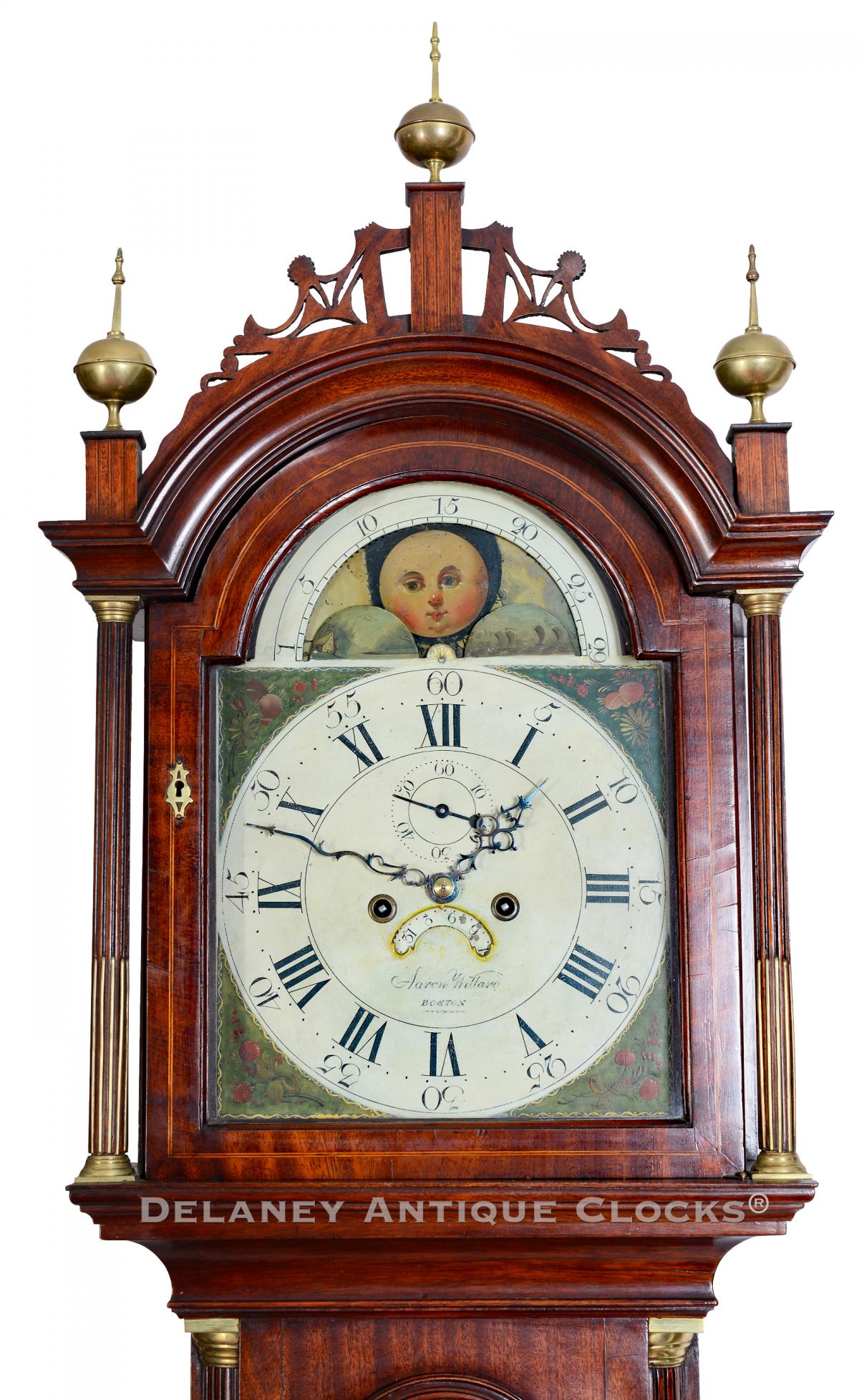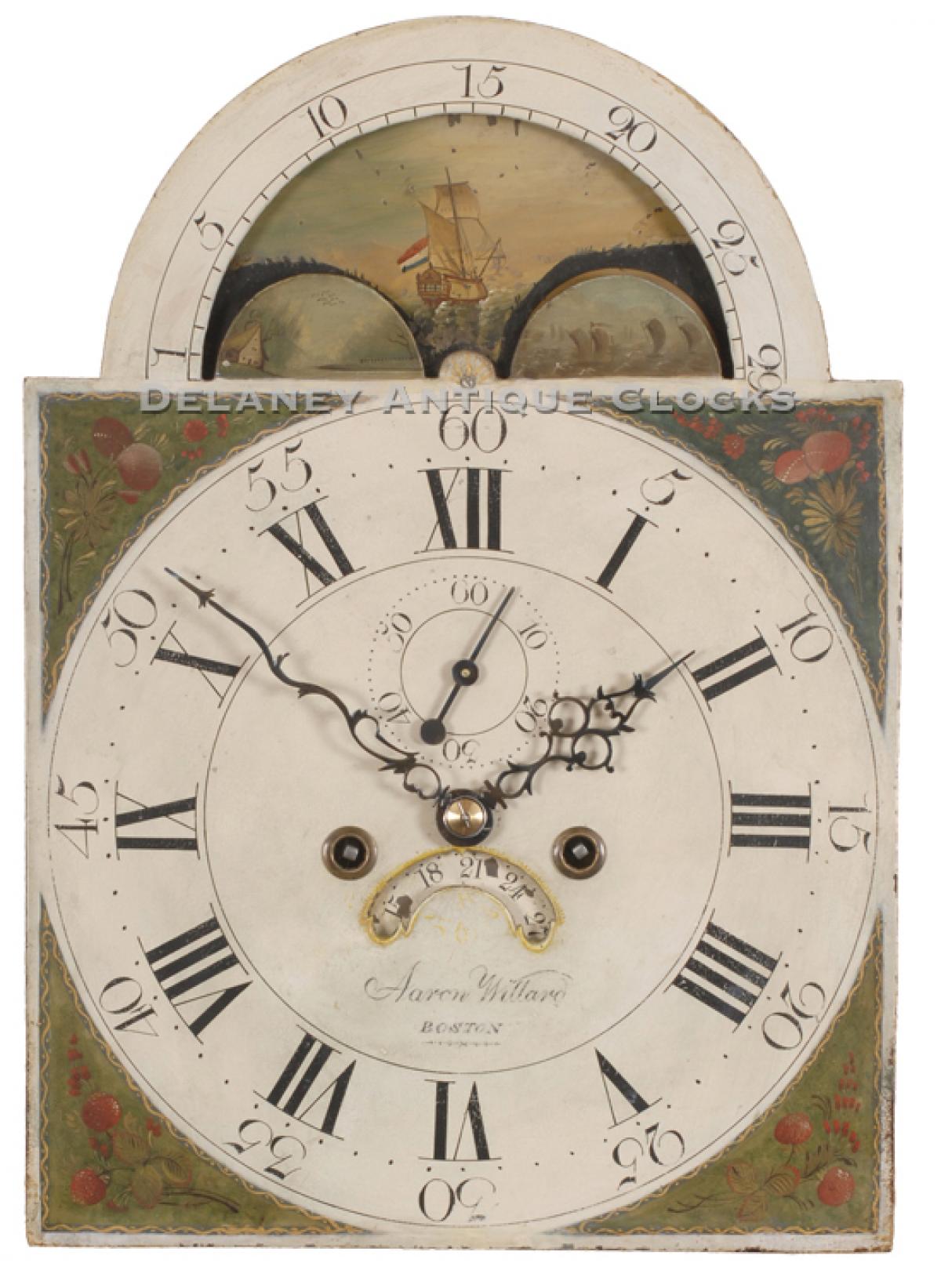Aaron Willard Boston. An Important Hepplewhite Inlaid Mahogany Tall Case Clock made circa 1800 for Nathaniel Meriman. The dial artwork is attributed to John Minot. DDD-10.
This attractive tall case clock is a superb example of an early “Roxbury” case produced in Boston around 1790. The case exhibits many of the finest qualities associated with this desirable form. These include high-quality mahogany selections, brass stopping in the columns, pattern inlays, a distinctive pierced and open fretwork pattern, and cuffed ogee bracket feet. This clock was produced by the important clockmaker Aaron Willard [1757-1844], brother to the renowned clockmaker Simon Willard. Aaron was a highly prolific Boston clockmaker for over sixty-five years, beginning after his apprenticeship in 1778. A patriot during the revolution, he moved to Roxbury with his brother Simon in 1780 and then to Boston, “on the Neck” in 1792. In his Boston workshops, the enterprising clockmaker employed up to 30 employees and produced many fine tall case clocks, many Massachusetts shelf clocks, and patent timepieces or banjo clocks. The brightly painted dial is an early example manufactured in Boston and likely decorated by John Minot. A fine Willard Roxbury tall case clock with important features like an early Minot dial and multiple pattern inlays is highly prized by serious collectors.
A handwritten note inside the waist door reads, “This Clock was made by Aaron Willard about 1800 for Nathaniel Meriam.”
This case featured the finest ribbon and figured mahogany woods that retain a rich color and pleasing surface. Three brass ball and spire finials are mounted on three lined-inlaid chimneys or finial plinths. These frame a distinctive Roxbury-type pierced fretwork. The fretwork and chimneys rest atop a molded arched cornice, all above a glazed tombstone-form dial door. This locking door is cross-banded with a double-line inlaid detail. Brass stop-fluted colonnettes with brass capitals and bases flank this door. It opens to a finely painted iron dial of Boston origin. Each side of the hood is fitted with a glazed tombstone-shaped window. Shaped quarter columns are mounted in the back corners of the hood.
This early Boston dial features a painted moon phase disk in the lunette. It is decorated with alternating hand-painted scenes. At the base of the lunette are two hemispheres, each decorated with hand-painted views. On the right is a harbor view with fishing boats, and on the left is a cottage scene with a river and a flock of birds. The early manufacture date of the dial is established by these painted scenes on the dial hemispheres. The more widely available dials manufactured in England typically had map transfers on the hemispheres. These transfers were not available for the first generation of Boston-made dials. While some hemispheres were left blank, the finer examples were painted with similar detailed scenes. This technique is attributed to the decorative painter John Minott, who was active from 1793 to 1826. Minot had a lengthy and productive business relationship with the Willards. The dial is framed with four corner spandrels decorated with vivid berry and blossom sprays on the green ground, all within gilt borders. The clock face has an inner ring of Roman numerals to demark the hours and an outer ring of Arabic numerals to demark the five-minute makers. The dial is fitted with steel pointer-formed hands and has a second bit above the center arbor and a calendar window below. The dial is signed below the calendar with the maker’s name and locale, “Aaron Willard / Boston.”
The hood transitions to the waist section with a broad flared molding. The waist is set with brass stop-fluted quarter columns that terminate in brass quarter capitals. These flank a molded tombstone-form pendulum door. The door has a brass keyhole escutcheon and a line inlaid border centering an inlaid conch shell. This door opens to access the original pendulum, constructed with a wood shaft and a brass-capped bob. A pair of tin can weights drive the works.
This fine movement is constructed in brass and is of good quality. Four-turned pillars support the two brass plates. Hardened steel shafts support the polished steel pinions and brass gearing. The winding drums are grooved. The escapement is designed in a recoil format. The weight-driven movement is designed to run for eight days on a full wind. It is a two-train or a time-and-strike design having a rack-and-snail striking system. As a result, it will strike each hour on the hour. This is done on a cast iron bell mounted above the movement. This movement has recently been serviced and is in fine running condition.
The waist transitions to the base section with another broad-flared molding. The base has a vibrantly grained panel decorated by a line inlaid border. Each corner is fitted with quarter fans. An inlaid conch shell exhibits excellent detail in the center of the board. The lower section has a double-stepped molding that joins to four ogee bracket feet. These feet are a specific form, with a distinct flared cuff, from the last decade of the 18th Century.
The case measurements are as follows: Height including center finial: 94 inches; Width: 20 3/8 inches; Depth: 10 inches.
This clock was made circa 1800.
Inventory number DDD-10.
Aaron Willard was born in Grafton, Massachusetts, on October 13, 1757. Little is currently known of Aaron's early life in Grafton. His parents, Benjamin Willard (1716-1775) and Sarah (Brooks) Willard (1717-1775) of Grafton had eleven children. Aaron was one of four brothers that trained as a clockmaker. In Grafton, he first learned the skills of clock-making from his older brothers Benjamin and Simon. It is recorded that Aaron marched with them in response to the Lexington Alarm on April 19, 1775, as a private under Captain Aaron Kimball's Company of Colonel Artemus Ward's Regiment. Aaron re-enlisted on April 26 and was soon sent by General George Washington as a spy to Nova Scotia in November. By this time, he had reached the grade of Captain. He soon returned to Grafton to train as a clockmaker. In 1780, Aaron moved from Grafton to Washington Street in Roxbury along with his brother Simon. Here the two Willards establish a reputation for themselves as fine clock manufacturers. They were both responsible for training a large number of apprentices. Many of these became famous clockmakers in their own right. The Willards dominated the clock-making industry in the Boston area during the first half of the nineteenth century. Aaron worked in a separate location in Roxbury from his brother and, in 1792, relocated about a quarter-mile away from Simon's shop across the Boston line. Aaron is listed in the 1798 Boston directory as a clockmaker "on the Neck," His large shop employed up to 30 people, while 21 other clockmakers, cabinetmakers, dial and ornamental painters, and gilders worked within a quarter-mile radius by 1807.
Some important dates for Aaron Willard include...
1783, Aaron married Catherine Gates. They have two children. The first is Aaron Willard Jr who becomes a very accomplished clockmaker. Catherine Gates dies in 1785.
1789, Aaron marries Polly Patridge. Polly has two sisters that also marry clockmakers Abel Hutchins and Elnathan Taber. Aaron and Polly have nine children. Two work-in-the-clock trades. George Willard 1817-1821 becomes a journeyman clockmaker. Henry Willard (1822-1887) trained as a cabinetmaker and made cases for the Willard operation when he came of age.
1792, Aaron builds a large home at 143 Washington Street in Boston. He lives in this house until he dies. This house is also the location of his workshop. A barn is converted into an area to finish wood. Other spaces in the carriage shop are rented to related artisans.
1802-1804, Aaron is in a business partnership with cabinetmaker James Blake as Willard & Blake. Aaron's position is financial.
1804, Aaron he transforms the carriage house and barn into a workshop space for artists, clockmakers, woodworkers, etc. It is now known as Willard's Compound.
1805-1806, Aaron is a financial backer in the partnership of Willard & Nolen. Spencer Nolen (1784-1849) is an ornamental artist who begins painting clock dials. In 1808, Spencer Nolen married Aaron Willard's daughter.
1823, Aaron Willard retires. He is 66 years old.
1844, Aaron died on May 20 and is buried in the Eustis Cemetery in Roxbury.
We have owned a large number of tall case clocks made by this important Maker. In addition, we have also owned a good number of wall timepieces, some in the form of banjo clocks, gallery clocks, as well as numerous Massachusetts shelf clock forms.




